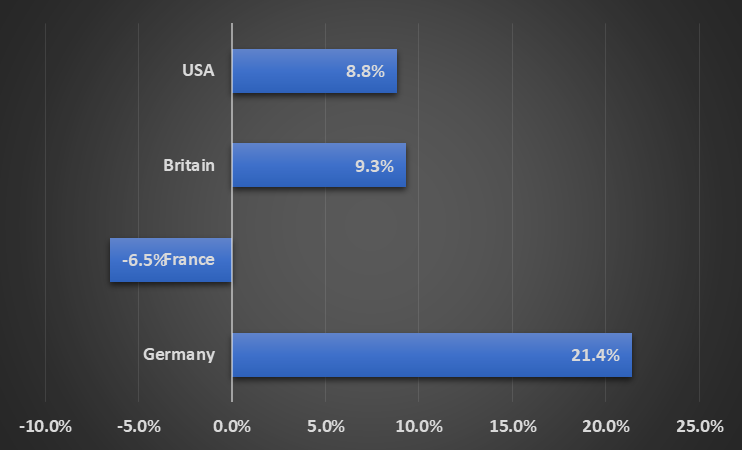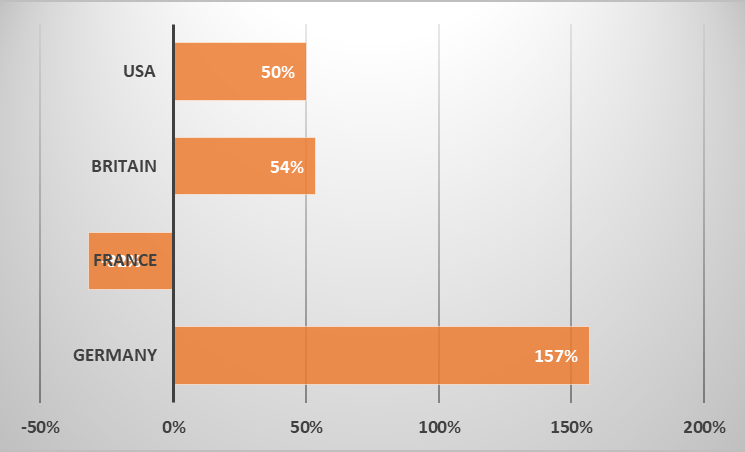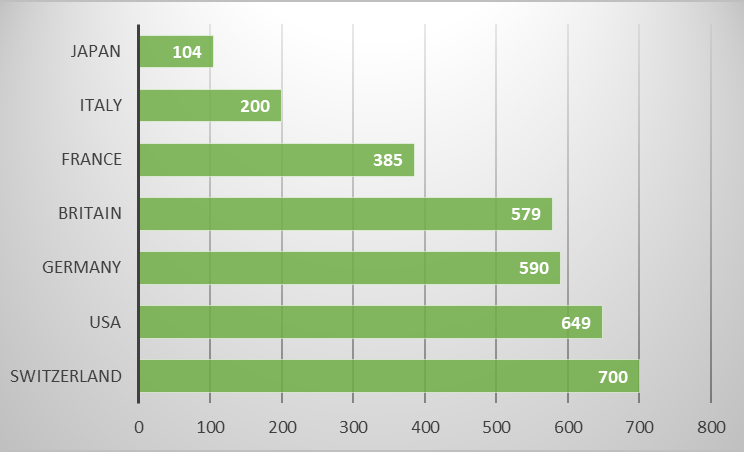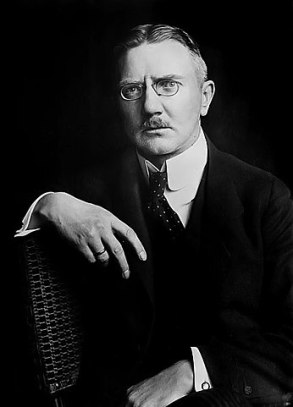 By itself, budget deficit (even a large one in absolute terms) is not really such a big deal. After all, these days just about every developed nation (with a notable exception of Germany) – the United States, China, Japan, France, Great Britain, Italy, Spain, etc. – runs a substantial budget deficit and has already accumulated an impressive national debt.
By itself, budget deficit (even a large one in absolute terms) is not really such a big deal. After all, these days just about every developed nation (with a notable exception of Germany) – the United States, China, Japan, France, Great Britain, Italy, Spain, etc. – runs a substantial budget deficit and has already accumulated an impressive national debt.
These deficits are not considered a major problem, because it is believed that government spending increases gross domestic product (market value of all the final goods and services produced annually in the country in question). In other words, fuels economic growth.
Which in a law-abiding country (and the Nazi Germany was very much so – Gestapo and Kripo took good care of that) automatically increases government tax revenue, enabling the latter to pay off public debt.
Provided, of course, that the latter (and budget deficit) stays within “common economic sense”. Which in the Third Reich was not the case – Adolf Hitler’s Mission was to win the existential war, not to keep the government books in balance. When the very existence of the nation was at stake, who cared about the damn financial accounts? Hitler and the Nazis obviously did not – and justifiably so.
As borrowings on international financial markets (now-standard means of financing government budget deficits), getting loans from foreign banks, printing money, and (God forbid) defaulting on its domestic debt were out of the question, Adolf Hitler had to resort to other ways and means of paying off massive government debts. Alas, to mostly criminal ones.
The obvious benevolent source of funds (successfully used in Italy by Il Duce) was large-scale privatization. Unfortunately, it was just about the only legitimate one – all other ones were very much criminal (if not outright murderous).
Despite all his hysterics about “the existential Jewish threat”, “racial war”, etc., one of the key reasons behind Hitler’s Judenrein project was a purely financial one. The fundamental objective of this project was to physically deport Jews somewhere outside Germany (and subsequently German-controlled territories) robbing them of all their valuables.
Which could then be used for either direct financing of German economic recovery or for paying off government debt accumulated by runaway deficit financing of economic growth.
There was another – far more sinister – idea that was actually implemented, believe it or not. Force Jews to lend money and other valuables to the Nazi government and then… kill them. A very common method used by the organized crime characters to deal with creditors. Which made Nazi state a very much criminal organization (in some ways not unlike the proverbial Mafia).
Like just about all other Nazi crimes, this one was a monumental blunder. It is a well-established fact that Jews are the most efficient and productive nation by far (in terms of creating aggregate value – financial, functional and emotional).
Which Jewish (forced) immigrants from Germany proved beyond the reasonable doubt in Palestine in the 1930s, performing an economic miracle quite comparable to (and in many ways more impressive than) the one performed by the Nazis in Germany at the same time.
Consequently, Germany would have been far better off using its Jews (and then the Jews on German-occupied territories as well) to generate financial, functional and emotional value than robbing, deporting and murdering them.
Especially given the fact that even the diehard Nazis knew that the tales about the “fabulous riches of the Jews” were just that – fairy tales. In reality, valuables taken from the Jews essentially at gunpoint (i.e. proceeds from armed robberies of the latter) were not nearly enough to pay off the mammoth national debt accumulated by the Nazis through their economic revival and rearmament programs (let alone wartime military spending).
Nazis desperately needed another source – and they quickly found it (most likely, it was known to them all along). Making someone else pay off their debts. This “someone else” included not only population of German-occupied territories (i.e. essentially German colonies in Europe) but also their allies – Italy, Romania, Bulgaria, Hungary, Slovakia and Croatia.
I will cover these crimes (and these were crimes indeed) in sufficient detail in the chapter devoted to Hitler’s crimes. In this section I will only touch a few key points.
Financial exploitation of occupied territories was mostly simple and straightforward (although Nazis did employ some highly creative financial schemes).
First, grab as many valuables as possible; sell them in the open market (domestic or international) and use the proceeds to pay off government debt. Second, exchange government bonds for land, buildings, other real estate or shares in businesses in German-occupied territories (i.e. colonies).
Third, force the population of newly-acquired colonies to work essentially for food, clothing and shelter; import products (foodstuffs mostly) into Germany; print money to pay off government debt and then use these products to “cover” printed money (thus balancing demand with supply and putting a firm check on inflation).
Financial exploitation of German allies was far more subtle and creative but was surprisingly explicit. Nazi message to their allies was cut and dry, plain and simple, loud and clear:
“We save you from being conquered and destroyed by the Bolsheviks and you must in return pay us with your money and with the blood of your soldiers”
As Nazis did not view their occupied territories in Western Europe as colonies (the latter was reserved to occupied territories in the East), their message to the citizens of France, Benelux countries, Denmark, Norway and Greece was essentially the same (sans “blood of your soldiers”).
However, even in these transactions (let alone in ones with neutral nations – also critically important for the Nazis), Hitler and his government had to solve one no less critical problem – catastrophic lack of foreign currency.
It is estimated that for its foreign trade to function properly, the country in question had to have sufficient reserves of foreign currency for six months. In 1933-34 Germany often had the reserves for six days. Making foreign trade work under such constraints was a genuine miracle.
The ways to deal with this potentially crippling problem, were obvious. Establish tight import controls (all imports had to be approved by a special government agency). Institute tight foreign exchange controls so that no individual or organization could take precious foreign currency out of the country over a very small limit.
Convince foreign vendors to sell their goods for Reichsmarks – and then use proceeds to buy German goods (thus fueling economic growth in the Reich). Develop and sign extensive barter agreements with foreign nations, essentially exchanging their goods for the German ones.
This was Hitler’s economic program in a nutshell. However, to make it and thus his Quantensprung – his economic miracle – a reality, he needed someone who would become his “economic tsar”, the “Führer of German economy”. Someone who would take responsibility for reviving the German economy, eliminating unemployment, getting Germany out of Great Depression and implementing a gargantuan rearmament program.
Fortunately for Adolf Hitler and Germany, there was exactly such a man in the Reich. Hjalmar Horace Greeley Schacht – a 56-year old (a very senior citizen by the standards of youngish Nazi leadership) prominent economist, banker and politician (in 1918 he was one of the founders of the centrist German Democratic Party (it was dissolved in 1930, way before Hitler came to power).
Hjalmar Schacht had impeccable credentials for this job. A half-German, half-Danish aristocrat (his mother was Baroness Constanze Justine Sophie von Eggers), he studied political science (among other subjects) at universities of Munich, Leipzig, Berlin and Paris before finally earning a Ph. D. in economics at a University of Kiel.
His doctorate thesis was on mercantilism – national economic policy designed to maximize the exports of a nation. A very appropriate topic for Germany in 1933 which desperately needed to earn (or at least conserve) foreign currency.
In addition to extensive banking experience in Germany (he rose to the position of a deputy director at Dresdner Bank – then one of the largest German banks), and in government service (he was the Banking Commissioner for Occupied Belgium and subsequently the currency commissioner in Weimar Republic), he had extensive – and very high-level – connections in international finance.
Which included the famous American banker J. P. Morgan, as well as U.S. president Theodore Roosevelt. And the Governor of the Bank of England, Montagu Norman, was so close to the Schacht family that he was godfather to one of Schacht’s grandchildren.
After his economic policies helped battle German hyperinflation and stabilize the German mark, Schacht was appointed president of the Reichsbank at the requests of then-President Friedrich Ebert and then-Chancellor Gustav Stresemann.
Like Adolf Hitler, Schacht was firmly committed to restoring German power and glory and making again a global political, economic and military superpower. By 1930, he became convinced that Weimar Republic would never be able to achieve this all-important objective and began slowly but surely drifting towards the Nazis (who in his opinion would – if they ever come in power in Germany).
Although he never officially joined the Nazi party, Schacht helped to raise funds for the Nazis. After the July 1932 elections, in which the NSDAP won more than a third of the seats, Schacht was one of those who organized a petition of industrial leaders requesting that president Hindenburg appoint Hitler as Chancellor.
On March 17th, 1933 (even before the Enabling Act gave him essentially absolute power in Germany), Adolf Hitler re-appointed Schacht as Reichsbank president (on March 7th, 1930 the latter resigned from this position over disagreement with then-Chancellor over payment of war reparations).
But it was obviously not enough. To make Schacht the genuine “Führer of German Economy” (in full accord with all-important Führerprinzip), Hitler had to make the banker Reich Minister of Economics as well.
And, of course provide him with the necessary support. Which would become possible only after crushing the opposition to the Nazis, transforming the Weimar Republic into a centralized Führerstaat and developing and implementing a mighty and omnipresent propaganda system.
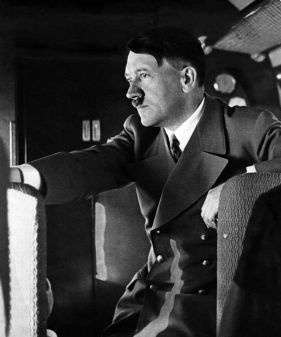 One of the many common misconceptions about Adolf Hitler is that he knew next to nothing about economics. In reality, he knew enough to (a) understand the “Mussolini Blueprint” – successful economic reforms implemented by Il Duce; (2) figure out how to adapt this blueprint to very different situation in Germany; (3) hire the best individual to the position of the “economic Führer” of the Third Reich; (4) control the latter and provide him with the necessary support; and (5) replace him with the more appropriate one once the initial Mission was accomplished.
One of the many common misconceptions about Adolf Hitler is that he knew next to nothing about economics. In reality, he knew enough to (a) understand the “Mussolini Blueprint” – successful economic reforms implemented by Il Duce; (2) figure out how to adapt this blueprint to very different situation in Germany; (3) hire the best individual to the position of the “economic Führer” of the Third Reich; (4) control the latter and provide him with the necessary support; and (5) replace him with the more appropriate one once the initial Mission was accomplished. Hitler considered “Il Duce” – Benito Mussolini – one of his role models (actually, the most influential one). His highly successful “March on Rome” became an inspiration for the (pathetic) Beer Hall Putsch. And Hitler’s economic policies and reforms followed the “blueprint” derived from also highly successful economic policies of “Il Duce”.
Hitler considered “Il Duce” – Benito Mussolini – one of his role models (actually, the most influential one). His highly successful “March on Rome” became an inspiration for the (pathetic) Beer Hall Putsch. And Hitler’s economic policies and reforms followed the “blueprint” derived from also highly successful economic policies of “Il Duce”.
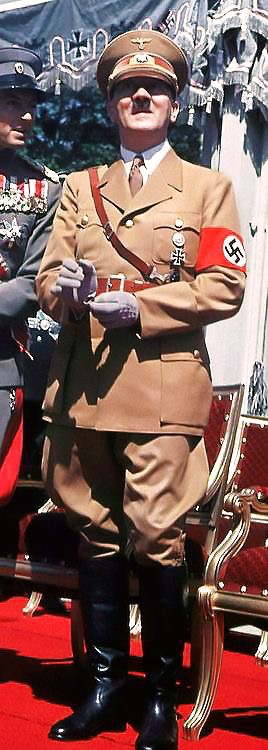 To properly understand and evaluate (functionally, of course) Hitler’s rearmament program, one must acknowledge and accept the irrefutable fact that it was an unavoidable necessity (as was the priority of guns over butter.
To properly understand and evaluate (functionally, of course) Hitler’s rearmament program, one must acknowledge and accept the irrefutable fact that it was an unavoidable necessity (as was the priority of guns over butter.